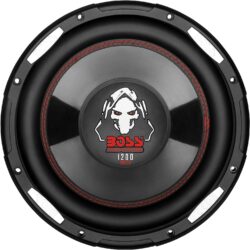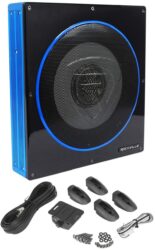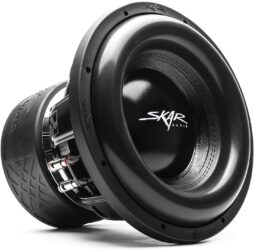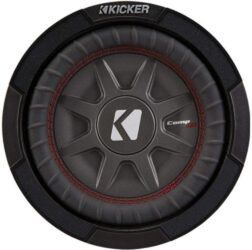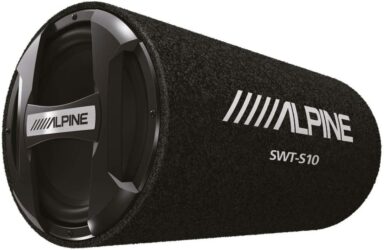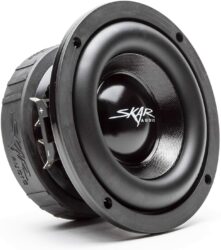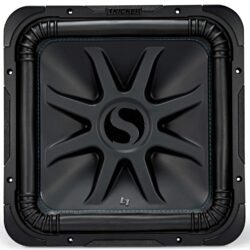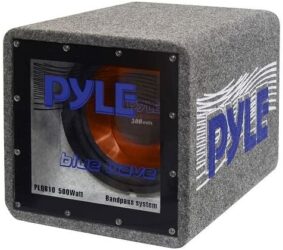Adding a subwoofer to your car’s sound system is often the best way to make a sound system go from ok to great. You don’t have to bust eardrums or rattle windows four blocks away, but cars often lack low-frequency response due to their smaller speakers.
Filling out the missing bass in the sound profile will make whatever music you listen to sound fuller and clearer. Plus, as much as the suburbanites might complain, blasting bass as you cruise the boulevards can be a ton of fun.
If you are looking to add a subwoofer to your car’s audio system, then you’ve come to the right place. In this article, we want to demystify the subwoofers’ world, starting with a quick guide and a top ten list with reviews. That top ten list will really be more of an introduction to all the styles and types of subwoofers you can add.
After the reviews, we’ll give you an in-depth guide and FAQ so you can know everything you need to get into the sweet world of bass.
- Subwoofers at a Glance
- Top 10 Best Subwoofers for Your Car 2025
- 1. Best Overall Subwoofer: Rockville RV10.2B 1000W Kit
- 2. Best Budget Subwoofer: BOSS Audio Systems P100F
- 3. Best Compact Powered Subwoofer: Rockville RW10CA
- 4. Best Premium Subwoofer: Skar Audio ZVX-12v2
- 5. Best Shallow Mount Subwoofer: Kicker 8” CompRT
- 6. Best Inexpensive Enclosed Subwoofer: MTX Audio Terminator Series TNE212D
- 7. Best Compact Enclosed Subwoofer: Alpine SWT-S10
- 8. Best Small Subwoofer: Skar Audio EVL-65
- 9. Best Entry Level Competition Subwoofer: Kicker Solo-Baric L7S
- 10. Best Inexpensive and Compact Enclosed Subwoofer: Pyle PLQB10 10” Subwoofer
- FAQ
- All About Subwoofers for Your Car
- Let Bass Wash Over You
Subwoofers at a Glance
Choosing the right subwoofer for your car can be very subjective and complicated. The biggest thing you need to know is that every part of a subwoofer’s design is a compromise. We talk about it at length here.
First, let’s talk about the types and forms of subwoofer you can get, and we’ll follow up by breaking down the specs and what those compromises are.
Types of Subwoofers
When you buy a subwoofer, you will come across a handful of different types. The following are the most popular kinds.
Powered Subwoofer
A powered subwoofer is a complete and straightforward way to add bass to your system. It’s an amp, enclosure, and speaker all in one.
Enclosed Subwoofer
Enclosed subwoofers are simply speakers that come pre-installed into a dedicated enclosure. Perfect if you have an amp and don’t want to build your own.
Component Subwoofer
A component subwoofer is just the speaker component of the system.
Kits
A subwoofer kit can include some or all the parts you need to add in an amp, speaker, and cabinet. Unlike powered subs, they are often separate components rather than an all-in-one device.
Vehicle Specific
Some cars have factory subwoofers that can be upgraded. Some companies make special subwoofer enclosures and speakers for certain models of cars. Since these vary greatly and are only suited for particular circumstances, we won’t include any in our reviews.
Numbers and Compromises
Like we mentioned above, subwoofers have a lot of numbers and features. In the big section below, we will go over the major concepts in greater detail. Here we will simply summarize most of them.
Diameter
The bigger the diameter, the more air you move and the more potential volume you have. However, big speakers take up a lot of space that most cars don’t have, and they are more likely to sound muddy at lower volumes.
Depth
A compact speaker is much easier to mount, but you sacrifice voice coil size to make a shallow mount speaker. That makes them less efficient.
Impedance
The lower the resistance, the more power. Higher resistances have better sound quality. Most cars stick to either 2 or 4 ohms, although some subwoofers are rated at 1 ohm.
Watts
Watts, short for wattage, measure the level of power that the speaker can handle. Generally speaking, you have to pay a lot more for higher power ratings.
Voice Coils
A speaker with multiple voice coils can be wired in different ways to optimize impedance or to wire multiple speakers in different configurations. Having multiple coils adds price and complexity.
Matching the Amp to the Subwoofer
One of the biggest things you need to keep in mind is that you should match the amplifier to the subwoofer. It’s fairly straightforward; simply match the watts RMS of the amplifier to the speaker wattage range at the correct ohm rating. When in doubt, make sure the amp is more powerful than the speaker.
So if an amplifier can produce 1000 watts at 2-ohm, your subwoofer or subwoofers need to have a rating of less than 1000 watts and have a resistance of 2-ohms.
Alright, time to get into the reviews. It’s important to know that there is a huge variety of subwoofer options. We will try to describe what each type and form is best suited for, but it’s impossible to know your specific scenario. First and foremost, make sure the subwoofer will fit in your car and be compatible with your sound system.
Top 10 Best Subwoofers for Your Car 2025
1. Best Overall Subwoofer: Rockville RV10.2B 1000W Kit
Why we like it:
If someone asked us what they should do to add bass to their car’s sound system, we would tell them to buy this kit. It’s just a very straightforward, low cost, and complete kit that you can’t go wrong with.
Quick Specs:
- Type:Enclosed
- Diameter:Dual 10”
- Mounting Depth:4.5”
- Enclosure Size:28x18x18
- Resistance:4-ohm
- Power Rating:350w RMS
- Voice Coils:1 Per Speaker
Best Suited For
This is the perfect kit for anyone that doesn’t want to do any math or extensive research but still wants to add a healthy amount of bass to their sound system. It’s got two 10” subwoofers pre-installed into a well-built ported enclosure, and comes with an amp to power them and the wiring to hook them all together.
You won’t be winning any competitions. In fact, at 350w RMS, you can burst your own eardrums, but the people at the back of the beach party will only just feel it. If you really need more power, buy a bigger sub like the Skar ZVX, buy a decent monoblock, and build your own cabinet. You will always get more out of a system you build part by part. You’ll also be spending about 5x as much for it.
Our Thoughts
You also won’t be wowing anyone. Rockville isn’t a major player like Skar or Kicker, and the low price comes with an inherently lower quality. It’s also completely non-customizable. If you don’t have space for a box that is a little over 2ft long and nearly 2ft tall and deep, the whole thing is pretty useless.
That being said, you can always upgrade each component as you get the budget to do so. Amp too small? Buy another one and you’ll already have the wiring and speakers for it. Subs not powerful enough? Replace them with pretty much any 10” and you’ll already have the enclosure.
At the end of the day, though, that’s not really what it’s for. It’s really for anyone with space and just wants to add sweet, sweet bass to round out their car’s sound system.
Pros
- It comes with everything you need
- The dual enclosed subwoofers are easy to set up
- It’s a really amazing value
Cons
- Rockville doesn’t have much street cred
- You can get a lot more quality and power if you source the components yourself
2. Best Budget Subwoofer: BOSS Audio Systems P100F
Why we like it:
It’s budget-friendly and big enough to rattle windows. Plus, Boss is sort of the leader in budget audio equipment because of their quality, and this sub is no different.
Quick Specs:
- Type:Component
- Diameter:10”
- Mounting Depth:4.6”
- Enclosure Size:Not Included
- Resistance:4-Ohm
- Power Rating:700w RMS
- Voice Coils:2
Best Suited For
Boss is the go-to brand for budget audio equipment, making this a perfect subwoofer for anyone who wants an inexpensive. That’s a little obvious, but it includes a lot of people that aren’t traditionally thought of as being budget-conscious.
For instance, people learning to build audio systems. You don’t want to go and ruin a new, super expensive subwoofer if you are just beginning your audio system journey. Ruin an inexpensive sub like this first, then you’ll know what not to do when you invest in better parts.
That being said, just be aware that Boss is a budget company. The parts are good quality, but not as high-quality as more expensive subs. The big Kicker subwoofer we recommend can easily survive exceeding max wattage a couple times. You have to be a lot more careful with the Boss.
Our Thoughts
A lot of people will shy away from budget speakers, but they can be worthwhile. They have a purpose, and as long as you understand that purpose, they won’t let you down. It’s not going to be the best sounding subwoofer, and it’s not going to outlast your car, but it will deliver hard-hitting bass. That’s all many people could want.
The one thing we will always fault Boss for, though, is their need to exaggerate numbers. The box for this speaker claims 1500 watts, which is amazing. However, that’s maxed wattage, and the speaker really can’t handle that.
Still, 700 watts RMS is a good amount, right? Except in the real world, it can’t even handle that. Stick to 450 watts as a realistic, survivable number, and you’ll be golden. That’s still enough bass to make your teeth shake; you just won’t be impressing anyone at the car show.
Pros
- It’s inexpensive
- It has decent enough quality
- Is a good size for many systems
Cons
- The ratings are exaggerated
- Sound quality could be better
3. Best Compact Powered Subwoofer: Rockville RW10CA
Why we like it:
All you have to do is run some wires to this little box, slide it under your seat, and enjoy the low frequencies that fill your cabin.
Quick Specs:
- Type:Powered Enclosed
- Diameter:10”
- Mounting Depth:2”
- Enclosure Size:12.4”x 13.4”x2.7”
- Resistance:2-ohm
- Power Rating:200w RMS
- Voice Coils:1
Best Suited For
There are two types of people that will love a small, all-in-one subwoofer. The first type is the group of people that look at the Rockville kit on our list and think, “Man, that’s still big and complicated. Isn’t there anything simpler?”
The answer is yes, there is something a lot simpler. This powered sub here. It’s just a blue box that you slide under your seat, the end.
The other type of person that will love this subwoofer is the type of person with a small car. If you own a Miata or a Wrangler, chances are you don’t have room for a big enclosure. In fact, you may not even have room for a separated amplifier.
This sub, amp, and enclosure combo is barely more than 1ft square, and that’s all the space you need. That will fit into just about anything, even after you stick a roll bar and remove the dash from your street rod.
Our Thoughts
Let’s talk about the bad things first. We talked at length in the short guide about sacrifices, and you definitely sacrifice a lot to keep things compact. A small enclosure has a lower response, less low-frequency quality, and a lot less volume.
That means that even compared to a very inexpensive sub like the Boss here, this Rockville sub’s audio quality can only be described as “ok.”
That being said, if you are just trying to round out the sound of a factory system, you will notice a huge improvement after you install this. Bass is essential for balancing a sound system. The average car lacks bass, so even a small upgrade like this is a beautiful thing.
Pros
- It’s very simple
- Very compact size
- An inexpensive option
Cons
- It doesn’t sound great
- It won’t rattle windows
Why we like it:
It won’t just shake the windows on your car; it will shake the windows on all the cars in your neighborhood.
Quick Specs:
- Type:Component
- Diameter:12”
- Mounting Depth:6.5”
- Enclosure Size:Not Included
- Resistance:1-ohm
- Power Rating:1,500w
- Voice Coils:2
Best Suited For
After you’ve upgraded your alternator, upgraded the big 3, are running an extra battery, and have a high-power amp wired in, you’ll need a big sub to take advantage of all that juice. This Skar is a great option. It’s 1-ohm and dual voice, so you can wire two of them up and use 3,000 watts RMS to blow the doors clean off your ride.
If there was anything in that last paragraph that you aren’t sure about, consider getting a smaller, less expensive sub. The Kicker CompRT is still a high-quality, great-sounding subwoofer, and you won’t have to sell a kidney to afford it.
Our Thoughts
There exist people in this world that are not satisfied until the amount of bass they can produce exceeds the threshold for damaging human hearing. This is a good subwoofer for those people. Skar makes great quality products, and they are well known enough that no one will give you any sass for showing up with a car running their components.
The thing you have to understand is that the price to use a speaker like this one, or especially larger speakers like the square Kicker on our list, is a lot steeper than just the price of the subwoofer itself.
You need expensive wires. You need an expensive amp, with an expensive electrical system. You need a high-quality enclosure. If you are up for that challenge, though, this subwoofer is absolutely awesome.
Pros
- It has high-quality construction
- Can handle a ton of power
- 1-ohm and dual voice for lots of wiring options
Cons
- It’s expensive
- It needs more skill to utilize
5. Best Shallow Mount Subwoofer: Kicker 8” CompRT
Why we like it:
The shallow mounting depth can help this sub fit into all sorts of weirdly shaped spaces that a deep sub can’t.
Quick Specs:
- Type:Component
- Diameter:8”
- Mounting Depth:2.7”
- Enclosure Size:Not Included
- Resistance:2-ohm
- Power Rating:300w RMS
- Voice Coils:2
Best Suited For
It’s a really fantastic sub for anyone that wants to add 300 watts of bass to a vehicle that doesn’t’ have much room. In fact, one of the places it really shines is in the cab of a truck. Most trucks have very little room for a big enclosure; you don’t have a trunk to fit the box, and you wouldn’t want a subwoofer bouncing around in the bed.
Most trucks do have some space between the front seats and the back seats or the front seats and the back of the cabin, and this speaker can fit nicely in that space.
The other place that this subwoofer fits nicely, and is often overlooked when talking about sound systems in general, is in factory subwoofer locations. 8in subwoofers are very common in premium sound options when a vehicle is built, but the factory subs are often on the low power side.
Since the cabinets are made to fit into tight spaces, there’s not much room in the enclosure. A shallow 8” like this one is absolutely perfect.
Our Thoughts
Kicker is one of the biggest names out there when you start talking about cars and bass. They use high-quality components and are famous for getting more volume with less power than their competitors. This shallow mount sub is a great answer for anyone that doesn’t need to break windows but still wants hard-hitting bass.
The downside is that a shallow speaker doesn’t have the response or range of a bigger speaker. Remember, everything is a compromise. It also costs more than a standard 8in, so it’s a better value to get a bigger speaker if you have the room.
If you don’t have the space for a bigger speaker, though, it’d be hard to do better than this.
Pros
- It has a great build quality
- It’ll fit into factory subwoofer locations
- Kicker is a brand worth showing off
Cons
- Not a lot of low-frequency response
- Expensive for an 8in
6. Best Inexpensive Enclosed Subwoofer: MTX Audio Terminator Series TNE212D
Why we like it:
It’s inexpensive, produces a ton of sound, and says Terminator on it. What more could you want?
Quick Specs:
- Type:Enclosed
- Diameter:Dual 12”
- Mounting Depth:4”
- Enclosure Size:29.7”x 14”x 13.5”
- Resistance:2-ohm
- Power Rating: 400w RMS
- Voice Coils:1 Per Speaker
Best Suited For
At the risk of stereotyping, this is the perfect cabinet for high schoolers. It’s not limited to high schoolers; it’s ideal for anyone on a tight budget and doesn’t really care about what other people think. It’s just that when you talk about people who don’t have a lot of money, have a car they can afford to make really impractical, and want really loud bass without much care about the actual quality of the bass, you just described many high schoolers.
That’s not a bad thing at all. MTX is a cheaper brand, and that absolutely has its place. Throw this cabinet in the back of your drift missile, so you don’t have to have a good cry when it falls out on turn 3. Just know that it’s not going to sound amazing like the Skar we recommend will. It’ll just be loud.
Our Thoughts
If you are just looking for a ton of bass on a budget, here you go. It takes up a ton of space, so you won’t be driving your family to the airport with their luggage anytime soon. It also doesn’t come with an amp, so it’s not quite as good a value as the Rockville kit is.
It’s louder, though, and bigger. It looks way more impressive, is what we are saying.
The real standout feature is the price. You can buy two of these units for less than a single 12in top-shelf sub. That’s four 12in speakers and two cabinets for the price of one fancy speaker. That makes it easy to overlook all the little build quality and sound quality issues.
Pros
- It’s inexpensive
- It produces a lot of volume
- It’s easy to hook up
Cons
- It takes up a lot of space
- The quality could be better all around
7. Best Compact Enclosed Subwoofer: Alpine SWT-S10
Why we like it:
A bass tube is a really great way to add low-frequency boom to a system, and Alpine’s quality means that this one will last.
Quick Specs:
- Type:Enclosed
- Diameter:10”
- Mounting Depth:3.5”
- Enclosure Size:11.2”(round) x 23.6”
- Resistance:4-ohm
- Power Rating:250w RMS
- Voice Coils:1
Best Suited For
Bass tubes offer a few advantages over the traditional enclosure design. First, and perhaps most importantly, they take up very little space without sacrificing enclosure size. It’s a very efficient design, so you can get a lot of volume out of a lot less space.
Especially if you stand it up and stuff it in the corner, it’ll hardly take up any cargo space at all, and you’ll still be able to make your ears ring.
The second advantage is more subjective. A bass tube has a much punchier, boomy sound. It’s muddier than a sealed box, and many people feel that lowers the sound quality. However, the sound has more punch to it despite the inaccuracy, so if you’d rather feel your bass than hear the exact timbre of a drum, then it’s a great option.
Our Thoughts
Alpine is one of the older names in audio, and they have a reputation for making good quality products. This tube is no different; it’ll outlast your car unless you accidentally drop something on it.
The downside is that even though it utilizes space really well, it’s still not exactly small. In fact, compared to the all-in-one Rockville, it’s gigantic. The unique shape will allow it to fit in places that traditional cabinets can’t, though, so it’s possible that you can use a bass tube where a box wouldn’t. It’s inexpensive enough that you can give a try without much risk.
Worst case scenario, just pop the speaker out and build yourself a new enclosure for it; it’s not like you’ll be disappointed with an Alpine subwoofer.
Pros
- The unique shape can fit into tight spaces
- Can produce more volume in the same space
- Alpine’s quality is top-notch
Cons
- Some people won’t enjoy the difference in sound
- It still takes up a fair bit of space
8. Best Small Subwoofer: Skar Audio EVL-65
Why we like it:
This minuscule subwoofer can still pack a serious punch and is highly responsive. It’s perfect if you don’t need a lot of volume, but want a ton of sound quality.
Quick Specs:
- Type:Component
- Diameter:6.5”
- Mounting Depth:3.56”
- Enclosure Size:Not Included
- Resistance:4-ohm
- Power Rating:200w RMS
- Voice Coils:2
Best Suited For
The first thought would be to say that this sub is the best suited for people who don’t have much space to work with, but the truth is that the shallow mount Kicker we recommend will take up less space with a properly sized cabinet. So will the Rockville all-in-one, which is really the best option if you have no space to work with since it can be thrown under a seat.
Instead, this 6.5in subwoofer offers really amazing sound quality at a great price, as long as you don’t need it to be too loud. It cannot move very much air, so even with a properly sized enclosure, you won’t be shattering eardrums anytime soon. Which is probably the best-case scenario if you want to continue listening to the music you love.
Our Thoughts
Skar somehow manages to make a tiny speaker sound like an entire bass cabinet. If you build a good box for it, you will be amazed at how good the response and depth is. If you’d rather listen to music on headphones in a studio than blasting over the PA at a party, then these little subwoofers are exactly what you need.
You are paying a lot for that quality. Compared to other 6.5in subs, the Skar is a bank breaker. It’s not expensive compared to bigger subs, but you can get a louder 6.5in for cheaper if you look around. When you blow that one up, though, the Skar will be here waiting for you.
Pros
- It’s high-quality
- The frequency response is excellent
- It’s very compact
Cons
- Despite being very compact, it needs a good amount of mounting space
- It’s expensive for a small sub
9. Best Entry Level Competition Subwoofer: Kicker Solo-Baric L7S
Why we like it:
These giant square subs are some of the hardest hitting on the market.
Quick Specs:
- Type:Component
- Diameter:15” Square
- Mounting Depth:8.5”
- Enclosure Size:Not Included
- Resistance:4-ohm
- Power Rating:1000w RMS
- Voice Coils:2
Best Suited For
Take everything we said about the big Skar subwoofer on our list, and dial it up a few notches. You need a hardcore amp to take advantage of this subwoofer, and you need to make sure all your cables and fuses are installed correctly. You also need a ton of space. This speaker alone is bigger than many single enclosures you can buy.
That being said, if you need the absolute highest pressure and the most volume, you need something like this. The square design gives it a lot more surface area than a comparable 15” round speaker. That means you are displacing the maximum amount of air and building the most amount of bass possible. You’ll feel it in the next town.
Our Thoughts
We said it before here, but Kicker is one of the bigger players in the subwoofer scene. Speakers like this one are the reason why. The thing is a monster. It weighs 35 pounds and has a surface area of over two square feet.
The downside is the price. Everything about it costs money and requires a lot of your time. Square mounting holes aren’t common, so you’ll be custom fitting it in no matter what. The square shape also isn’t as good at reproducing accurate sound as a round speaker is. That’s sort of a minor detail when the goal is to be incredibly loud, but we aim to be complete.
Pros
- It pushes a ton of air
- The square design is very space-efficient
- It’s really powerful
Cons
- It’s really expensive
- The square design can be inconvenient
10. Best Inexpensive and Compact Enclosed Subwoofer: Pyle PLQB10 10” Subwoofer
Why we like it:
It’s a simple, clean enclosure that looks very stylish. It’s not powerful enough to turn heads, but people will ask about it if they see it in your trunk.
Quick Specs:
- Type:Enclosed
- Diameter:10”
- Mounting Depth:4”
- Enclosure Size:12”x 12” x17”
- Resistance:4-ohm
- Power Rating:250w RMS
- Voice Coils:1
Best Suited For
There are a lot of these kinds of cheap, small, ready to rock subs on the market. They all sort of function the same; they are an inexpensive speaker in an enclosure that’s too small. Buy a $40 monoblock off your favorite discount website, and you’ll have the cheapest system on our list.
Which is the perfect thing for your beater, daily, or hand me down car that you are afraid to put too much effort or cash into. You can enjoy a nice bass boost in the old Camry you bought just to get from school to home on the weekends.
On the off chance that some loser smashes the passenger window and grabs the box, you can laugh since they’ll only get like five bucks if they try to sell it on craigslist.
Our Thoughts
It’s a nice, small enclosure. That’s what we can say confidently. The see-thru face is neat, and the stitched carpeting looks good. The speaker inside is where they saved all the money. So if you really fall in love with the little unit, rip the old speaker out and replace it with a Boss 10.” Those are still inexpensive, and they are a huge upgrade.
The only thing that can make it hard to justify is that you can pick up a little powered sub that will fit under the seat, and they don’t cost very much more. The Rockville here won’t get as loud, and it certainly doesn’t look as good, but it does have its own amp. It all comes down to whether you want to do more work and get a better sound or if you’d be fine with the under-seat deal.
Pros
- It looks good
- The enclosure is well designed
- Inexpensive
Cons
- Speaker quality isn’t great
- The enclosure could be bigger
FAQ
If you still have burning unanswered questions about subwoofers, we’ve got you covered. We’ve answered the most common ones below.
Honestly, and we mean this with no snark, wherever it fits. A subwoofer in an enclosure is a big piece of equipment. You’ll often find them in the trunk of a car, in the cargo area of an SUV, and under the seats of passenger trucks. Ideally, you want them close to the amplifier and behind you.
It depends. A bigger amp will produce more volume but may be less responsive. It’s more important to choose an amp size that fits neatly into your vehicle. That includes the enclosure size; if you have to have a smaller enclosure, a smaller speaker will be better.
All things being equal, two subs will be louder than one. More surface area means more air pressure, and that means more volume. However, it takes more energy to move two cones, so it’s not a huge difference.
If you feed the same amount of power to each, the bigger subwoofer will be slightly louder. However, the enclosure and type of speaker will have more effect on volume than the diameter. If volume is your biggest concern, running multiple small subwoofers in a large enclosure will produce a lot more volume than a single, larger subwoofer.
Generally, you want an amplifier that exceeds the subwoofer’s rating, so if an amplifier can produce 400 watts at 2 ohms, get a 2-ohm subwoofer that is less than, but close to, 400 watts.
All About Subwoofers for Your Car
Subwoofers have a lot of variation, and the more you get into it, the more complicated they can become. Don’t worry about knowing everything; even experts often argue about the details.
The best thing to do is start by understanding some of the key concepts of speaker design and subwoofer care.
Hoffman’s Iron Law
There is a set of rules for speaker building. They extend to everything from tweeters to woofers and down to subwoofers. Collectively they are known as the awesome sounding Hoffman’s Iron Law.
Basically, it states that there are three ideal properties of a speaker:
- First, a speaker should have great frequency response, or bass extension. Good bass is the foundation of sound quality.
- Second, speakers should be The more efficient a speaker is, the more volume you get from the same amount of wattage.
- Finally, the speaker can’t be too big. Having a small size is essential because we live in a space-limited world.
This final feature extends to the enclosure and is especially important because cars have a lot of space constraints.
Even though we would love a small, super loud speaker that can play every frequency in existence, Hoffman’s Law tells us that you can only choose two features.
- A subwoofer that is small and sounds great won’t be able to produce very much volume. Picture your favorite set of earbuds.
- A large subwoofer that can handle a lot of power has to be built out of sturdy materials. Those sturdy materials won’t have the frequency response that a lightweight sub would have.
- A subwoofer that is large and sounds great, like the 12” Skar on our list, requires a ton of energy. In the case of the Skar, you are looking at needing 100 amps from your car’s 12v system.
- A subwoofer that can get loud and doesn’t take up much space, like the Rockville powered sub, doesn’t have enough room to sound great.
There is a cheat code. It’s the same cheat code for a lot of different problems in life: money. Modern engineering can produce small subwoofers that can get loud and sound amazing. There’s no such thing as a truly compromise-free speaker, though, so you have to trade a lot of money for it.
Understanding Watts and Ohms
Two numbers really dictate everything in the audio world. The number of watts and the number of ohms. Wattage, or watts, is the product of multiplying amperage and voltage together. It represents how much power something has available.
Ohms represent the amount of impedance across a speaker. As a quick note, you’ll often see the words resistance and impedance used interchangeably.
- Technically, DC voltage, like the kind you get from a battery, has resistance.
- Alternative voltage, like from your wall outlet or the signal for speakers, has impedance.
They are both measured in ohms, and no one will ever quiz you on the difference. More importantly, ohms are represented by the omega symbol (Ω).
Watts RMS
Most speakers and amps will have two separate wattage ratings: the maximum watts and the watts RMS. Maximum wattage is not a very useful measurement. Think of maximum wattage as the speed you can run from a bear. You might be fast for a while, but you probably can’t keep it up for very long.
Watts RMS, or Wattage Root Mean Square in case someone asks, is the measurement of the amount of wattage a speaker can handle for long periods. In our bear analogy, picture jogging instead of running in terror.
Impedance
Car audio systems tend to be built around either 4-ohm speakers or 2-ohm speakers. Generally, the higher the resistance, the better the audio quality, so you want 4 or more ohms for your main channels. The trade-off is that the higher the ohm value, the more power it takes to get the same volume.
Bass, however, doesn’t need to sound as clean as higher frequencies to sound good. Most people want to maximize volume, so many subwoofers are 2-ohm or even 1-ohm.
Wiring Multiple Subwoofers Together
One subwoofer is straightforward. If you have a 200w sub rated at 2-ohms, you need to power it with around 200 watts from an amp rated at 2-ohms.
When you start adding multiple subwoofers, things get complicated fast because there are many different configurations, and they all affect the total watts and total ohms differently. The best thing to do is take a glance through this guide made by Kicker.
Enclosure Design
That’s a lot of math, and I wish we could say it’s over, but we have to talk briefly about enclosures first.
Ported vs. Sealed
Enclosures are divided into two main categories. Ported, sometimes called vented, enclosures have a hole in them. Sealed enclosures don’t.
People who like tight, responsive bass should go for a sealed enclosure. If you prefer big booms and max volume, a ported enclosure will serve you better.
Size
The size of the enclosure is directly correlated to volume, to an extent. Most manufacturers will tell you their recommended size for whichever speaker you buy. You’ll have to balance that with the amount of room you have. There’s also free, robust software that can help you calculate the size and design.
Building vs. Buying
If you are buying an enclosed subwoofer or a kit, then the work is probably already done for you. That’s the easiest way to do things, but building a custom enclosure to fit inside your vehicle can give you the best space utilization. It’s also the only way to make sure the enclosure matches your interior.
If you do plan on making your own enclosure, we suggest watching two videos. This first one is from Donut Media. The host builds his own box from scratch and summarizes many other key concepts we went over in this article.
This second one is from someone who builds a much more complicated enclosure and really demonstrates how far you can go with a custom design.
Other Parts of Subwoofer Design
The following things are not necessary to know to get into the world of bass. They are, however, things you will come across in your audio system journey. Each one is its own rabbit hole of information, so beware.
Coil Design
Beyond the number of coils, the voice coil’s size and shape can greatly affect the sound.
Cone Shape
Simply put, the shape of the speaker itself will change the properties of the sound it produces.
Construction Materials
Every part of a speaker can change the sound. The voice coil material is tied to resistance, and the durability and frequency response of the cone change greatly based on the type of paper or plastic they are made from. Even the type of magnet can affect the type of sound produced.
The Temperature
Not only does a speaker produce its own heat as it runs, but the ambient temperature can change resistances, the way materials behave, and how much energy is needed to move the cone.
You can read about a lot of these features and more here. It’s dense, but if you have some time to kill and really want to know why a Skar speaker will outperform an MTX speaker, it’ll set you on the right path.
Breaking the Subwoofer In

This is the final thing we will share with you before getting to some frequently asked questions. You must break in a new subwoofer. Here is an explanation with a guide, although they are much more thorough than most people will be.
Also, you don’t need a tone generator. You can get all of the break in frequencies on YouTube; just stream it to your head unit from your phone.
Let Bass Wash Over You
There are a lot of people who love feeling the music in addition to hearing it. Adding a good subwoofer is the perfect way to accent that feeling.
We hope this guide inspires you to at least take the first steps on your sound system journey. Or inspires you to blow the doors off your car with pure sound pressure; that’s awesome too.


